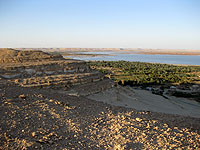Oasis Siwa - Settlement and Economic Structure in Hellenistic-Roman Times

Despite its remote location, the Siwa oasis formed a central intersection of important caravan routes and was in constant contact with the Nile River delta, the Fezzan, the northern coast of the Mediterranean and the Cyrenaica. The Amun Oracles, which became famous in archaic-classical times, helped the oasis to gain over-regional meaning. In Roman times, it became an important exporter of dates and olive oil. The settlement and economic structures has not yet been investigated because previous research mostly focused on the Amun-oracle. Especially in the Roman-Hellenistic age, Siwa was much more populated and used more intensively for agriculture than it is today. Numerous ancient settlements and necropoles can be localized on the shores of the Zeytun lake east of the oasis, which is abandoned today. The project, which is a cooperation with the Egyptian Antiquities Authority, aims to investigate the settlement and economic structure of the eastern part of the oasis in the vicinity of the Zeytun lake. A first prospection season was conducted in the spring of 2009. Currently, the project is on halt.